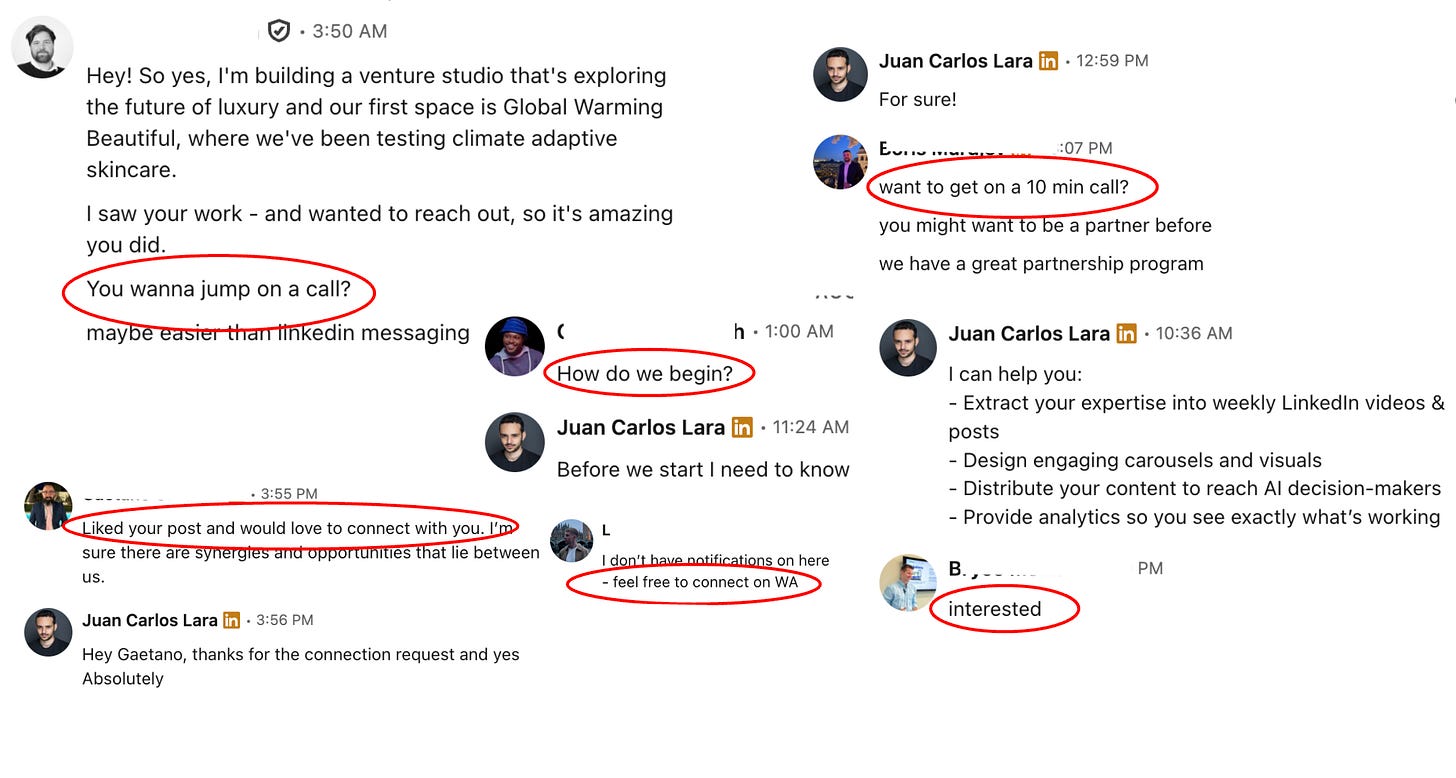Moneyball for LinkedIn content creation
How to write great content, get feedback and land more "runs"
Intro
In baseball, wins are the ultimate measure of success. For your content, “wins” could mean achieving key business outcomes such as generating leads, increasing conversions, or boosting brand awareness. Your content isn’t just about the creative process; it’s about driving measurable results.
Runs = Foundational Engagement:
In Moneyball, runs are the building blocks that lead to wins. In content creation, think of “runs” as the smaller, foundational metrics like engagement (views, likes, shares, comments) and reach. These are the elements that, when optimized, cumulatively drive your larger business outcomes.
Application:
Analyze Your Metrics: Start by identifying which foundational metrics (runs) most closely correlate with your business objectives (wins). For instance, if a high engagement rate on LinkedIn posts consistently leads to more business inquiries, then that engagement is your “run.”
Invest Strategically: Just as the Athletics sought undervalued players who could reliably produce runs, focus your energy and resources on content strategies that boost these key engagement metrics, even if they might seem less flashy initially.
Test and Learn:
Just like adjusting strategies based on player performance in Moneyball, regularly review your metrics. Test different content styles, formats, and CTAs to see which combinations yield the best conversion rates.
Focus on Data-Driven Decisions:
Use the data from your impressions and lead conversion rates to continuously refine your approach. The aim is to find the sweet spot where the number of impressions (runs) consistently results in engagement (likes, comments) or quality leads (wins).
Think of these successful posts as your “high on-base percentage” players, like how the Oakland A’s looked for players who consistently got on base. You want to replicate what makes these posts engaging, then refine and repeat.
Some posts are “super insightful” but don’t perform as well. Often, if the hook or headline doesn’t grab attention in the feed, people simply scroll by.
Lack of Immediate Relevance
If the topic isn’t obviously linked to a known figure, trending issue, or a strongly felt pain point, it may be harder for your audience to connect with it in a quick-scroll environment.
Presentation Format
Even if the content is gold, a big block of text can be intimidating. On LinkedIn, short paragraphs, bullet points, and whitespace can improve readability.
Key Insight:
These posts are like players with potential but a lower on-base percentage. They may have great “fundamentals,” but if they don’t catch the audience’s eye (the pitcher’s pitch they can actually hit), they won’t get on base.
Double Down on “Hook + Insight”
Hook: Start with a bold statement, surprising stat, or trending topic. Use numbers and facts.
Insight: After you’ve hooked them, deliver your valuable insight.
Action Step: Test headlines that reference timely, high-interest topics (public figures, current events, big numbers), but still tie back to your core message.
Leverage Trending & Evergreen Topics Together
Trending: Mention relevant figures or current events to ride the wave of existing interest.
Evergreen: Add your deeper, timeless insight to give the post substance.
Action Step: If you talk about a public figure or brand, connect it to a principle or lesson that remains useful long-term.
Use Visuals & Formatting
Visual Thumbnails / Memes / GIFs: Visuals can significantly increase impressions and shares on LinkedIn.
Bullets & White Space: Break up text to be skimmable. People often decide in seconds whether to keep reading.
Action Step: Whenever possible, include an image or short video (like you’ve seen with memes or public figure clips).
Ask for Engagement
Call-to-Action (CTA): Ask a direct question or prompt at the end of your post. LinkedIn’s algorithm boosts content that sparks comments and conversations.
Action Step: End each post with something like, “What’s your take on this?” or “Have you tried something similar?”
Experiment with Post Timing
Track When Your Audience Is Active: If your target audience is online at certain times, posting then can give you an initial engagement boost.
Action Step: Test different posting times and compare impressions.
Cross-Pollinate
Tag People & Pages (Where Relevant): Mention others in your niche or industry, this can bring in their audience too.
Comment on Others’ Content: Being visible on popular threads can drive more profile visits and impressions for your own posts.
Iteration & Data Tracking
Set a Baseline
Over the next week or two, track the performance of each post, impressions, likes, comments, and click-throughs.
Create a Simple Spreadsheet
Columns: Date, Topic/Headline, Format (text, video, meme), Impressions, Engagement (likes/comments), Observations (why you think it worked/didn’t).
This is your “sabermetrics.” You want to see patterns in how certain “stats” (format, headline style, topic) correlate with “runs” (impressions).
Review & Refine
After you have a few weeks of data, look for patterns: Do short videos with a bold opening line outperform text-only posts by 2x? Do posts mentioning a known figure consistently hit higher impressions?
Scale Up What Works
Once you find a winning format + hook, replicate it with different topics. If your “public figure + brand lesson” formula gets 2-3x more impressions, do more of that.
Moneyball Phase 2 - Building a Winning Streak
In the movie, once they nail the metrics, they:
Commit to the system: no panic changes mid-season, trust the data.
Motivate & align the team: make sure every player understands why they’re doing this. This is where something like Employee advocacy comes in.
Fill the gaps strategically: pick up players who fit the system (even if unconventional).
For content, that’s:
1. Commit to the Playbook
Once you’ve identified 1–2 winning formats, don’t scatter.
→ E.g., If “public figure + lesson” and “carousel brand breakdowns” outperform by 2x, keep publishing them weekly.
2. Build a Support Team
In baseball, no player wins alone. In content, no post wins in isolation.
→ Support posts with comments on relevant accounts, repurpose winners across channels, and collaborate with partners for amplification.
Encourage your employees to start posting too; this is how brands like ColdIQ are booking hundreds of calls. Each member of the team is encouraged to drive growth by consistently putting out content.
3. Fill the Gaps → Allbound System
Content gets you inbound, but the “wins” (revenue) happen when you pair it with outbound:
Inbound: Your content builds trust + awareness.
Outbound: You proactively connect with people who engage or fit your ICP.
Allbound: The hybrid: using content as the opener in outreach (“Saw you liked my post on X, here’s a deeper resource”).
Identify these types of signals to increase the chances of success when you do decide to outreach to your ICP, it will make your message stronger and the timing better.
Moneyball Phase 3 - The Postseason Mindset
At the end of Moneyball, the A’s didn’t stop because they had a formula, they kept evolving:
New data sets, new ways to find undervalued plays.
Building depth in the roster so a single player’s slump didn’t tank the team.
For you, that means:
Always testing 10–20% of content outside your proven formulas (to avoid stagnation).
Documenting your process so someone else can run it.
Scaling with additional distribution: podcasts, guest features, webinars, etc.
Key takeaway:
The “wins” in LinkedIn content Moneyball come from pairing your data-driven content engine with a proactive pipeline system. Without Allbound, you’re like the A’s hitting singles but never sending runners home.
"Turn your voice into visibility.
Most founders know they should post on LinkedIn, but few have the time to write, edit, and publish consistently.
That’s where we come in.In just 60 minutes a week, we turn your ideas into a steady stream of strategic, founder-led content that builds authority, attracts inbound leads, and grows your personal brand, without you lifting a finger on editing or posting.
Want to see how this works for you? Send me a message, let’s talk, connect with me on LinkedIn here: https://www.linkedin.com/in/juancalara/ 👈






